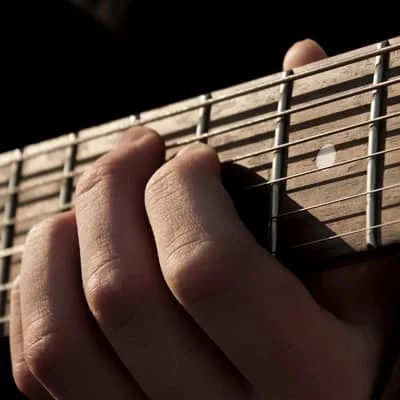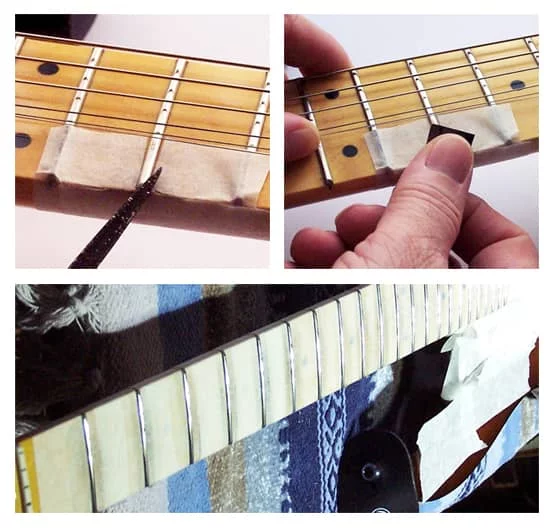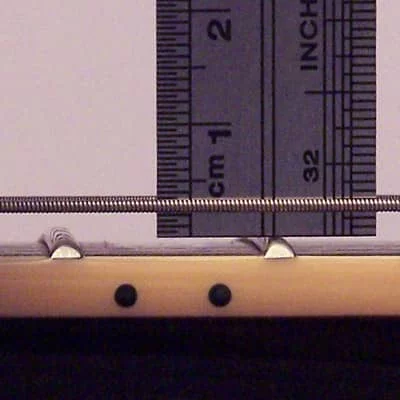
DISCOVER How to Improve the COMFORT of an Electric or Acoustic Guitar: Condition of the Frets, Condition and Height of the Strings, Nut Width, Saddle Height, and Basic Adjustments. The Best Solutions for You to Enjoy Playing the Guitar.
Is my Guitar Unplayable, or am I the bad guy? I suppose many of us have asked ourselves this question at some point. Well, on this page we will analyze the factors that can help us play better or more comfortably, and the causes that can hinder our technique on the electric guitar, and especially on the acoustic guitar.
Since this type of guitar is more likely to be unplayable if it is not adapted to our particular circumstances. Although many of these factors and improvements can be applied to both acoustic and electric guitars.
How to Improve the COMFORT of Guitar: Worn Guitar Frets
Worn Guitar Frets
The poor condition of the frets can be one of the reasons why our Guitar is quite Uncomfortable. Or even make the playing technique significantly more difficult, by preventing optimal sliding of the fingers across the fretboard.
With use, the guitar strings wear down the top of the frets, and lose their original rounded shape, creating edges on both sides of the fret.
These edges can make it difficult for your hand to slide across the fretboard. Consequently, we will notice how these edges retain our fingertips when trying to slide them over the strings.

To solve this problem we should apply crowning of frets to the guitar, so that they recover their rounded shape.
On the other hand, we can slow down the wear of the frets by always keeping the strings very clean, especially the part that comes into contact with the fret. This way we will prevent this dirt from eroding the metal, both on the string and the fret.
Badly Finished Frets
Something very common in the manufacture of guitars is the lack of meticulousness in the finishing of the fret ends. An job that requires time, and will undoubtedly raise the final price of the instrument. But annoying edges can also be generated at the fret ends, which will make it uncomfortable for your hand to slide along the neck.
To soften these edges we can round the fret end a little, with a precision file. But first we must tape the neck with masking tape, so as not to damage the varnish or the wood.

This is just an example for you to see, but this is how a good taping should look (image above). If the tape breaks when using the file, we would have to re-tape the exposed part.
Even so, we should carry out this operation carefully and without rushing. Since it is a meticulous job, and there are many extremes to iron out. So patience will be our ally to be able to do optimal work.
After applying the rounding with the file, we will have to run a 600-grit sandpaper over the end of the fret to smooth the surface, and then a 1000-grit sandpaper to finish. To recover the shine, we carefully apply a metal polish with a cotton pad, before removing the masking tape.
How to Improve the COMFORT of Guitar: Condition and Gauge of the Strings
String Cleaning
As I have already mentioned, dirty or bad strings can cause excessive wear on the frets, but they can also affect our technique, as the strings lose their softness and elasticity over time.
For this reason we should keep our strings in good condition, using string cleaners that apart from cleaning the string, provide a light lubrication that favors the sliding of the fingers. These cleaners are advisable to use after playing to clean, and also before playing to lubricate strings that have lost the characteristic softness of a new string.
String Gauge: What Should You Use?
The gauge strings has a clear influence on the feel of the guitar. It would be advisable to know the string gauge of our new guitar, for to buy the same thickness if we feel the guitar is comfortable, or to act accordingly if we do not feel the instrument to our liking.
Although it never hurts to know the standard gauges. For example, the 9 – 42 is the most used in the Fender style long scale, and the 10 – 46 in the Gibson style short scale.
In acoustic guitars it is very normal to find the gauge 12 – 53. Since for purists it would be an intermediate gauge, because they normally prefer the 13 – 56, in search of a tone optimized to the maximum.
But honestly, a 12 gauge can already be harsh depending on the guitarist. I personally use the 11 – 52 gauge on acoustic guitar, and I have noticed a palpable improvement in comfort compared to the 12 gauge. Although we will lose a little volume and tone along the way, for the benefit of a better playability, since it is of little use playing badly on a guitar with a great tone. I hope you understand the concept that I want to convey to you.
We can find string gauges for acoustic guitars 10 – 47 if it is necessary to further soften the feel of the guitar, if we need to bend string without risking tendonitis.
Furthermore, to progress to heavier gauges, we always have time to test whether we feel the acoustic guitar is too soft.
How to Improve the COMFORT of Guitar: Nut Width and Neck Profile
The width of the nut and the profile of the neck can influence our way of playing, so it would be advisable to orient both factors to our particular needs. Since a wide profile can benefit some and harm others, as can nut width.
In any case, this topic in the current market is normally oriented towards thin neck profiles, and narrow nuts of between 42 and 43 mm on electric guitars.
This trend is also followed in acoustic guitars, but since they are different instruments, it is more common to find slightly thicker neck profiles, and slightly wider nuts, generally between 43 and 44 mm.
Once we know the parameters that interest us, it will be easier to make the right purchase online. Or if we are very used to electric guitar necks, we can look for an acoustic guitar that is as similar as possible to the neck of an electric guitar. Since we can find acoustic guitars with a nut width that can exceed 44 mm.
How do you Set Up a Guitar so it is Comfortable to Play?
String Height
Previously we have discussed the issues to take into account regarding the ergonomics of the guitar with respect to the guitarist. But now we will move on to the adjustment parameters. These adjustments directly influence the feel of the instrument, as much or more than the previous ones.
For example, inappropriate string height is the biggest enemy of playability. This height can be easily modified from the bridge of the electric guitar. Although this adjustment must be accompanied by an optimal adaptation of the truss rod.
A comfortable string height is considered, around 2 mm from the 12 fret to the bottom of the sixth string.

In the event that fret buzz appears when playing forcefully, we should simply moderate our way of playing. Although when it comes to the electric guitar, these slight buzz on the thicker strings when we play a little louder is considered a musical part, especially when we use distorted sounds.
Improve the COMFORT of Guitar: Nut Adjustment
Another adjustment that can make a guitar difficult to play is a high string height at the nut. In this case, it is best to ask a professional for advice, or if we dare, we can sand the lower part of the nut if we notice too much separation of the strings.
Acoustic Guitar Excessive Saddle Height
Something very common to find is a high saddle height on acoustic guitars, to enhance the volume of the instrument. But most of the time the saddle usually allows a more precise adjustment of string height. This adjustment would be done in the same way as the nut, since it would involve sanding the lower part of the saddle on a solid block of sandpaper, or going to a professional.

The Guitarist Must Also Adapt to the Guitar
Although the guitar must mutate a little to adapt to us, we must also mutate a little to adapt to the guitar.
Many times we think that our hands have become stronger and more agile, when in reality it is that our fingertips have hardened, and consequently the strings feel less sharp, and therefore more manageable.
In short, our hands need a mutation process, to turn us into a kind of superhero who can do anything, compared to a guitarist with little experience.
But super powers are not eternal, since we must refresh our calluses as much as possible. So lack of practice is the Kryptonite that will turn us back into vulgar earthly beings.
For this reason, the use of the acoustic guitar is highly advisable to put our calluses in top shape, due to its greater hardness compared to the electric guitar.
